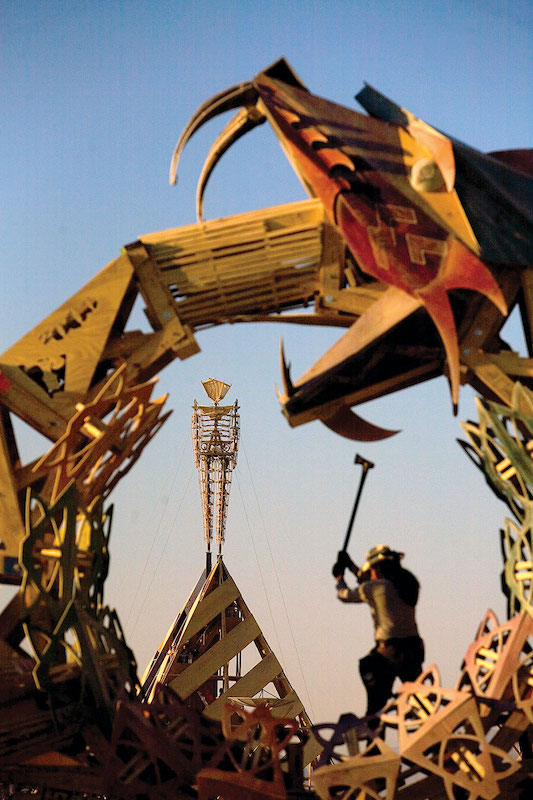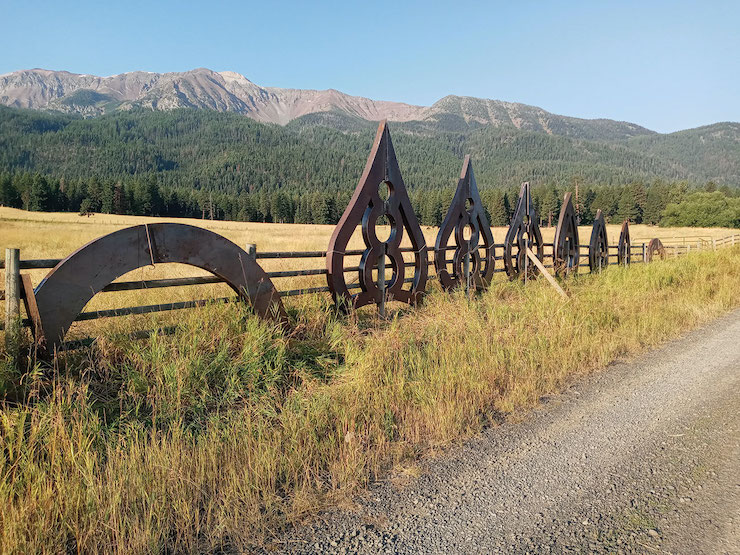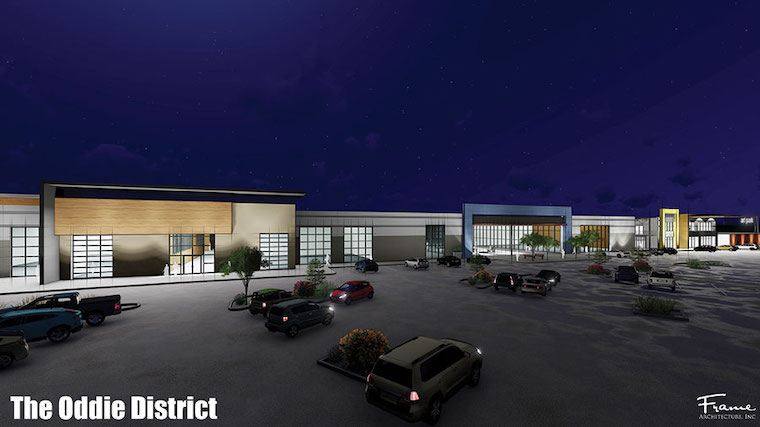
01 Dec Burning Man’s New Reality
While artists and would-be attendees made the most of the 2020 cancelation, the future of the counterculture gathering in the Black Rock Desert remains uncertain

Intricate art pieces are commonly displayed at Burning Man, culminating with the burning of a large wooden effigy, photo by Ryan Salm
Over Labor Day weekend, when caravans of cars, RVs and art-filled trailers traditionally stream onto the Black Rock Desert for the annual Burning Man festival, a group of revelers descended haphazardly onto the playa for an unsanctioned celebration. Meanwhile, thousands of burners were beaming into online Burning Man events held around the world.
Online or unsanctioned, many burners found unconventional ways to celebrate despite the official gathering being canceled by the coronavirus pandemic. But Burning Man’s absence raised numerous questions about the future of the art, funding and community that surrounds the event—as well as the event itself.
Burning Man Goes Digital
Multiverse was always the planned theme for Burning Man 2020, but the theme took on a new meaning when the famous experimental event moved online instead of gathering in the dusty landscape.
The event was split into multiple digital experiences—eight universes and 10 official events (eight of which were free) crafted by technologically advanced burners dead-set on still having an official Burning Man. The worlds, or “verses,” all had their own quirks, staying as true as possible to the essence of Burning Man.
Even though it was digital, in many ways, it was all there: The mutant vehicles, the original artwork, the otherworldly musical performances and, most importantly, the burner family.
The verses included interactive elements including virtual reality meetups. One virtual space named The Cathedral provided portal windows that opened to performance venues and multiple experiential art worlds. The Mushroom, another virtual stage, offered a place for musicians, artists and presenters to reach online attendees. Even the artists chosen for Burning Man Project grants—called honoraria artists—who were never funded had a space in the multiverse, though pieces were created digitally. Event hosts added digital versions of famous past artwork.
“We estimate that more than 100,000 people participated in the eight virtual worlds of The Multiverse,” says Megan Miller, director of communications for the Burning Man Project.
What many may not know is that a digital platform for Burning Man isn’t new. Since 2003, BURN2 has offered a “Second Life” virtual Black Rock City experience. It was a way for those who couldn’t attend Burning Man to get some of the same experiences from home. With no in-person event in 2020, interest grew, and the platform featured plenty of avatars outfitted in their playa best. Just like the playa, BURN2 was open 24/7 throughout the event as a central hub for burners to meet up, explore the world and host epic dance parties.
For the famous end to the playa festival when the Man is burned, Burning Man hosted a Burn Night: Live From Home, featuring 24 hours of content, including livestreams of gatherings happening around the world. Julia Nelson, an honoraria artist from Palo Alto whose digital sculpture was added into one of the verses, attended with friends and used a virtual reality headset.
“It reminded me of Burning Man,” she says. While in the Multiverse on burn night, Nelson met another burner from Chicago and had a full conversation with their avatars while standing in the middle of her friend’s living room.
Renegade Celebration
Many burners still showed up to the Black Rock Desert to celebrate the festival, with several renegade art events happening throughout late summer and early fall, including the regularly scheduled weekend.
Burning Man organizers publicly condemned the event.
“As members of our global community continue to honor Burning Man culture this weekend, we urge everyone to refrain from gathering unsafely in large groups, maintain public health and respect local, state and federal guidelines,” read a Burning Man Project post on Twitter. “Let’s all help prevent the spread of the COVID-19.”
Labor Day Weekend’s event in Black Rock City was dubbed the Secret Burning Man of 2020, or, more officially, Not Burning Man 2020. Several thousand attendees gathered in the desert to light smaller wooden effigies in honor of the event that wasn’t.
Tahoe local Rusty Reams, who has attended Burning Man festivals since 2007, celebrated at the renegade event, as well.
“It gave me a vision of what Burning Man was like before it got so popular,” he says. “It was way more raw, wild and completely untamed.”
While the event was “low-key and loose,” according to Reams, the biggest drawback was a lack of community, although he says he’s not sure if it was due to the missing organizers or the nerves surrounding COVID-19.
“People really kept to their group rather than freely roaming and openly interacting with all the other people out there,” he says.

Michael Benisty of Belgium was among the few artists who brought a large sculpture, called Rise, onto the playa for this year’s non-official Burning Man event in the Black Rock Desert, courtesy photo
Ultimately, for Reams, the renegade event represented what Burning Man is all about. “To me Burning Man has been always about exploring the established boundaries of society and at times going beyond them in order to discover new realities. So, to drive out to the playa without any idea of what to expect, and to venture on an uncharted journey into the unknown was completely refreshing and exhilarating,” he says. “It transformed the ‘unknown’ from something to be worried and concerned about into something that was enlivening and exciting.”
After the event, much of the art stayed out on the playa and some remains there to date. It’s still uncertain whether 2020 original Burning Man art will find a place in Reno’s growing art scene, where much of it eventually lands while awaiting private sale.
In addition to the celebration on the playa, revelers honored Burning Man with a gathering September 5-6 at San Francisco’s Baker Beach, where the first Burning Man events took place in the 1980s. It was also condemned by Burning Man organizers and largely regarded as selfish and unsafe by the general public.
While most of the art was smaller this year—due to the lack of funding that usually pays for Burning Man’s bigger pieces—Michael Benisty, a Belgian artist who often showcases his works in the Black Rock Desert, brought a large sculpture dubbed Rise to the playa, which features a shiny, naked figure shooting flames into the air. It was an accompaniment to his piece Surrender, a veiled figure with similar aesthetics. The goal was to represent a transformation in 2020.
“Surrender has been self-funded and Rise was a sculpture that was to be unveiled for EDC [the Electric Daisy Carnival] in Las Vegas this past May,” Benisty says. With the event cancellation, however, Benisty decided to bring both to the playa for a short stay.
“There’s no more incredible scenery than the playa,” he says, “especially an empty playa.”
Art on Pause
According to Jessi Sprocket, communications director for The Generator in Sparks, a makerspace where much of Burning Man’s art is designed and constructed, most of the art for the 2020 event never got off the ground. While many artists start planning their designs in March and April, the actual building typically doesn’t start until closer to May, says Sprocket. Plus, grant funds were never released, which means those giant installations weren’t funded.
“As far as funded art, none of it had been made yet. We had just selected the honoraria artists for 2020 when it became clear that we would not be able to build Black Rock City in the desert,” Miller says.
Some artists designed and built on their Multiverse pieces despite knowing the event was canceled. Nelson, for example, is constructing a piece that includes three buildings and many adornments.
“We kind of made this commitment to ourselves that we were going to build this because it made sense,” she says.
The process, however, is different than a normal Burning Man build, which is usually stressful and crazy and completed in just a few months before it is set on fire. Because she is spending more time on details, Nelson says this will be the first piece she’s worked on for Burning Man that she won’t burn, hoping to show it at other places.
Without any funding from Burning Man, Nelson is using free materials for construction. Some money, however, has been raised through a fundraising campaign on UnboundArts.org.
Ventura-based artist David Oliver, another honoraria awardee, took a leap of faith on his project, Petaled Portal, before plans for Burning Man 2020 went south. Oliver was fundraising and borrowing to create the piece before honoraria funds were dispersed, with plans to pay off the loans when he received the capital. When that money didn’t come, Oliver was left with debt and no funding. He landed on a farm in Joseph, Oregon, with a man who agreed to help pay for Oliver’s piece in exchange for building constructs for his property. If the 2021 event doesn’t happen, the Petaled Portal—an extension of his 2019 piece named Portal—will stay on the farm.
According to Sprocket, the vibe at The Generator even early on was that there was no point starting on large Burning Man installations. To fill their time, artists housed at The Generator focused on smaller projects. Sprocket says she personally was building pieces for hotels and private sale, and a group of makers even constructed a two-story fort for her daughter in the backyard.
“I can tell we are all desperate to build big art,” Sprocket says.
That may still happen after a one-year pause.
“Our intention for 2021 is to roll over the funding to the same projects that were selected for 2020, if we’re able to do so,” Miller says.

Petaled Portal created by artist David Oliver sits on a farm in Joseph, Oregon, while awaiting its planned appearance at Burning Man in 2021, courtesy photo
Planning for 2021
Burning Man tickets run about $475, while parking passes for the 2021 event start at $140, according to the website. And with about 80,000 people in attendance every year (the website says there is room for 70,000 at the 2021 event), it’s easy to see how the Burning Man Project funds programs throughout the year.
But COVID-19 has taken its toll. The Burning Man Project didn’t make any money off of renegade events because there were no tickets, no gates and no personnel on site. With lost funds, the future of Burning Man could be rocky.
“It’s far too soon to say what will or won’t happen in 2021,” Miller says. “We’re raising funds to keep our core staff intact and our nonprofit operational so that we can bring Black Rock City back as soon as it is safe to do so.”
Sprocket says she received a survey from the Burning Man Project asking questions about possible 2021 attendance. “I just don’t feel like it’s going to happen,” she says.
Nelson agrees. “My gut tells me we will gather on the playa in 2022 and it will be a huge celebration and people will be desperate for tickets,” she says.
The loss in revenue prompted organizers to launch a fundraising campaign in an effort to raise $1.5 million by the end of October and ultimately $12 million in total to bring Burning Man back in 2021, if the virus allows.

The Generator, a makerspace where much of the art for Burning Man is designed and constructed, will move into a new building on Oddie Boulevard in Sparks in 2022, courtesy rendering
The Generator’s New Home
In the midst of the Burning Man turmoil, The Generator, where much of the Burning Man art is constructed, also hit a bump in the road. During the pandemic, the group lost its lease and moved into The Reno Public Market as a temporary space until January.
But soon the makerspace will make a more permanent move, occupying 40,000 square feet in the former Lowe’s building in Sparks on Oddie Boulevard. The Generator’s new permanent home will include creative flex-tech offices, makerspaces, small shops, food and beverage offerings (including a large open-air brewery), and work-live studios for artists and entrepreneurs.
The project is estimated to cost $30 million and is scheduled for completion in spring 2022.
Doug Wiele, president and founding partner of Foothill Partners, Inc., says that his real estate group asked The Generator to become the cornerstone of the project both to boost art in the Reno-Sparks community as well as to take advantage of its reputation and local following. The Generator, which has a 10-year lease, will also supply artwork for display in the Art Park, which will take up space where the Lowe’s garden center once was.
“We are thrilled about this project,” Wiele stated in a press release. “The Generator is a cultural icon of Reno/Sparks; to provide it a long-term home, to surround it with working environments for design, engineering and production companies, and to build together a broad culture of innovation and creation will be great for Sparks and for the region.”
Nora Heston Tarte is a Reno-based lifestyle writer whose interest in Burning Man stems from its art. She spends many free weekends immersed in the local art scene, which is often flanked by big Burning Man pieces.




No Comments